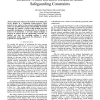Free Online Productivity Tools
i2Speak
i2Symbol
i2OCR
iTex2Img
iWeb2Print
iWeb2Shot
i2Type
iPdf2Split
iPdf2Merge
i2Bopomofo
i2Arabic
i2Style
i2Image
i2PDF
iLatex2Rtf
Sci2ools
IPSN
2005
Springer
2005
Springer
Lifetime-aware intrusion detection under safeguarding constraints
: This paper addresses the problem of maximizing the service lifetime of a distributed battery-powered sensor network in the context of the network interdiction problem under user-specified initial energy and probability of detection constraints. We consider a version of this problem where the probability distribution of selecting paths by the intruder is known to the interdictor. A two-step solution technique is proposed in whereby first the safeguarding constraints are satisfied and then the scheduling problem is solved. Experimental results demonstrate the effectiveness of the proposed two-step approach.
Battery-powered Sensor Network | IPSN 2005 | Network Interdiction Problem | Sensor Networks | User-specified Initial Energy |
Related Content
| Added | 27 Jun 2010 |
| Updated | 27 Jun 2010 |
| Type | Conference |
| Year | 2005 |
| Where | IPSN |
| Authors | Ali Iranli, Hanif Fatemi, Massoud Pedram |
Comments (0)

